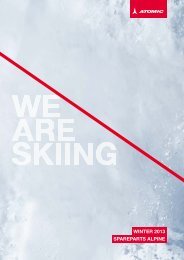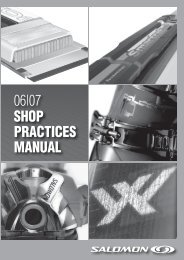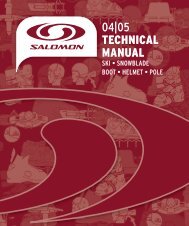SPM 05 ENvFIN.indd - Salomon Certification
SPM 05 ENvFIN.indd - Salomon Certification
SPM 05 ENvFIN.indd - Salomon Certification
You also want an ePaper? Increase the reach of your titles
YUMPU automatically turns print PDFs into web optimized ePapers that Google loves.
Pre-Season Binding Inspections<br />
Adjustment<br />
The purpose of pre-season binding inspections is to ensure<br />
that all components are functioning properly. Start by preselecting<br />
several samples representative of your rental boot<br />
inventory. These samples must pass all visual inspections<br />
(see Final Checking) and should be clean. Select sample<br />
boot sole length according to the Pre-Season Inspection<br />
Table (see previous page).<br />
Make all appropriate binding-to-boot adjustments. If there<br />
are any preset or Synchro binding adjustments, verify<br />
their accuracy. It is suggested that the indicator of each<br />
binding component be set according to the Pre-Season<br />
Inspection Table.<br />
All used bindings should be cleaned and lubricated before<br />
performing the following inspections:<br />
• Test for Lateral Elastic Travel and Return.<br />
• Test for Vertical Elastic Travel and Return.<br />
• Verification That Release Values are Within<br />
Specified Range.<br />
Pre-Season Boot Inspections<br />
Adjustment<br />
Pre-season boot inspections verify that boots in inventory<br />
can be used interchangeably with all appropriate bindings.<br />
Visually inspect all boots for compatibility and interchangeability<br />
according to criteria listed on Preparation &<br />
Installation. Correct any boot compatibility defect(s) that<br />
are found. If the defect cannot be corrected, the boot<br />
must be removed from inventory.<br />
Used Boots<br />
A random sample of 5% (not less than 16 nor more than 80<br />
units) of inventory must be tested according to the following<br />
procedures. The sample should include one boot typical of<br />
each boot cell (a boot cell is defined as all boots of the<br />
same make, model, year of manufacture and sole length).<br />
• Select two skis with bindings of the same model.<br />
• Adjust both bindings to release at their mid-range<br />
“Reference Value” of the appropriate “Visual Indicator<br />
Setting” using a mechanical testing device with a typical<br />
boot in good condition of the appropriate Sample Boot<br />
Sole Length.<br />
• Clean both bindings with mild dish washing soap and<br />
water at all boot interface (contact) points and wipe<br />
them dry.<br />
• Label one binding “clean.”<br />
RENTAL & DEMO MOUNTING<br />
PRE-SEASON INSPECTIONS<br />
Note: Any binding component that tests outside the<br />
“Inspection Range” should be inspected and re-tested.<br />
If the new results are still outside the “Inspection Range,”<br />
but within the “In-Use Range,” a correction factor* must<br />
be applied to bring the mechanical test results within the<br />
“Inspection Range.”<br />
For any binding component that tests outside of the “In-use<br />
Range” refer to Troubleshooting.<br />
• Apply a thin film of mild dish washing soap to all<br />
boot interface points of the other binding and label<br />
it “lubricated.”<br />
• Using a mechanical testing device, measure and record<br />
the twist test result (clockwise or counterclockwise) in<br />
one direction only and the forward lean test result of<br />
the random sample boot in the “clean” binding.<br />
• Measure and record the twist test result in both<br />
directions and the forward lean test result of the<br />
random sample boot in the “lubricated” binding.<br />
• The test results of the lubricated test must be within<br />
the "Inspection Range" for the appropriate setting.<br />
• The test results for the clean test must be within the<br />
“Clean 25%” range for the appropriate setting.<br />
• If either the clean or lubricated test results fall outside<br />
the acceptable ranges, re-inspect the boot, correct the<br />
defect, and re-test the boot. Remove from inventory any<br />
boot that does not pass both tests. Re-inspect, repair (if<br />
necessary) and test all suspect boots of the affected cell.<br />
New or Unused Boots<br />
A single unit random sample typical of each boot cell (boots<br />
of the same make, model, year of manufacture and sole<br />
length) must be tested according to procedures used for<br />
testing in the Used Boots section.<br />
> Reference<br />
Final Checking<br />
Pre-Season<br />
Inspection Table<br />
Test for Elastic<br />
Travel & Return<br />
Release Value Within<br />
Specified Range<br />
Troubleshooting<br />
Standard Boot<br />
Sole Dimensions<br />
* A correction factor is determined by<br />
adjusting the binding component’s visual<br />
indicator scale at half-setting intervals to<br />
bring the binding component’s test result<br />
to within the “Inspection Range.” This<br />
correction factor must then be placed<br />
on the ski next to the affected binding<br />
component (toe/heel) and recorded in<br />
your ski/binding maintenance records.<br />
43<br />
26<br />
42<br />
27<br />
28<br />
29<br />
8








